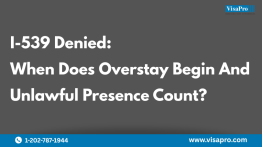Introduction
“I just entered the US. I have a US visitor visa (B1/B2 visa) in my passport that is valid for 10 years. At the port of entry the immigration officer issued me an I-94 saying I was admitted for 6 months. How long can I stay in the US: 6 months or 10 years?”
Lack of knowledge or misunderstanding about the role of a “visa” and the “I-94” has been a major factor for many foreign nationals falling out of status in the United States. What is the difference between visa and I-94? Which one determines how long can you stay in the US – the I-94 card or visa?
US Visa Vs. Form I-94: An Overview
A US visa is a permit to seek entry into the US. The I-94 card gives you permission to enter and remain in the US. A visa allows you to appear at the US port of entry and seek entry into the country. The I-94 form is your actual admission ticket, telling you how long can you stay in the US during that visit, and what you can do while you are here.
Many foreign nationals are unaware that their authorized stay in the US is controlled by the I-94 record and not by their US visa. It is the I-94 record that says how long can you stay in the US, and in what status you were admitted. Incorrect interpretations of the dates on the I-94 record or visa could cause problems.
My Case Scenario
Jae Yong
Jae Yong, a Korean Citizen who is a reporter for the Korean Times Newspaper, is being transferred to the US as a foreign correspondent for the paper. He will be stationed in Washington, DC and will be reporting on US politics. He is granted the I visa for journalists and media representatives. The visa is valid for 5 years. When he enters the US his I-94 is marked D/S for “duration of status.” This means that as long as Jae is working as a foreign correspondent for the Korea Times Newspaper he can stay in the US. There is no end date by which he is required to leave the US regardless of what the expiration of the visa is. Since his I visa is valid for 5 years, he is allowed to use the visa for 5 years to travel in and out of the US.
Let’s look at another example which highlights the difference between a US visa and the I-94 card:
A Citizen of China who wishes to enter the US as an H-1B professional cannot get an H-1B visa that is valid for more than 12 months. If a Chinese Citizen has an H-1B approval notice that is valid for 3 years, he or she can be admitted for the length of the approved petition, regardless of the expiration listed on the visa. This means that the individual must travel to the US within 12 months of being issued the visa. After entering the US he or she will be able to stay till the end date on the approval notice. He or she would only need to depart the US on or before the date specified in his or her I-94 form.
Now that we have a general overview of the Form I-94 and the visa let’s look at the specifics and the differences between visa and I-94.
1. What Is Form I-94?
The Form I-94, also known as the Arrival/Departure Record, serves as evidence that a nonimmigrant has entered the country legally. It indicates how long the nonimmigrant may stay in the US during that visit. It is the I-94 expiration date – and not the expiration date of the US visa – that controls how long a nonimmigrant may legally remain in the US.
REMEMBER
Generally, a new I-94 record with a new date is issued each time a nonimmigrant legally enters the US.
2. I-94 – How Do You Get One?
When you enter the US as a nonimmigrant, a US Customs and Border Protection (CBP) officer will examine your passport, visa, and may question you about the reason for your visit. If the CBP officer is satisfied that you qualify for the nonimmigrant classification you are seeking, and that you will abide by the US immigration rules, he or she will admit you into the US. The CBP officer will stamp your passport with the admission date, the class of admission, and the date that you are admitted until.
The procedure for securing the I-94 card will vary depending on whether you are arriving at an air, sea or land border port of entry.
| Arriving At A Land Border Port of Entry | Arriving At An Air or Sea Port of Entry |
|---|---|
| Paper Form I-94s are issued at land border ports of entry. You must complete a CBP Form I-94 Arrival/Departure Record and submit it to the CBP Officer when you arrive at the land border port of entry. The CBP Officer will keep the top portion of the Form I-94. The Officer will place a stamp on the upper right hand corner of the bottom portion. The stamp will contain the entry date and port of entry. The Officer will usually write in a specific date or “D/S” (duration of status) within the stamp along with visa classification. The bottom portion of the CBP I-94 form will then be stapled in your passport, normally on the page opposite your visa. | Nonimmigrants arriving at an air or sea port of entry do not need to complete the paper CBP Form I-94 or Form I-94W. CBP gathers travelers’ arrival/departure information automatically from their electronic travel records. CBP will create an I-94 record but a paper form will not be provided to you at the port of entry. You will be able to access the Automated I-94 information and I-94 number within a few days of entry. The CBP officer will stamp your passport/travel document with the date of admission, the class of admission and the date your stay will expire, if applicable. The I-94 arrival/departure record will be available online and you can print I-94 record from online at www.cbp.gov/I94. |
|
It is this record — not your visa – that tells you when you must leave the United States. If you have “duration of status” you may remain in the US as long as you are in the same job or attending the same school. NOTE: Citizens of the countries on the US Visa Waiver Program list who are entering the United States for a short stay and who are not US Citizens or US Permanent Residents, must fill out Form I-94W instead of the CBP Form I-94. |
3. Form I-94: What Does It Look Like
In order to qualify for an H1B, foreign nationals who have education from outside the U.S. must demonstrate that their education is ‘equivalent’ to a 4-year U.S. bachelor’s degree.
4. Form I-94 – What Is Its Purpose?
The Form I-94 serves as the arrival/departure record for foreign nationals admitted to the US as nonimmigrants. This document is created by US Immigration when the foreign national is inspected upon arrival at a US port of entry. The I-94 form indicates the date of arrival, status granted (i.e., F, J, H, L, etc.), and length of authorized stay. The I-94 is an official record of admission and permission to remain in the US.
IMPORTANT
If a foreign national either needs to remain in the US for longer than the time granted, or decides to change the status and remain in the US beyond the I-94 expiration date, he or she must file an application for an extension of stay or a change of status with US Citizenship and Immigration Services (USCIS).
5. What Is A Visa?
A visa is a stamp placed into the foreign national’s passport. It is issued by a US Embassy or Consulate, usually in the foreign national’s home country or country of residence. A US visa allows the foreign national to seek entry to the United States in a certain visa status within the time period (validity period) specified on the visa. A visa may allow one, two, or multiple entries before the expiration date of the visa.
6. Differences Between The Visa And The I-94
It is extremely important that you clearly understand the difference between a visa and the I-94. The major differences between visa and I-94 are as follows:
a.The I-94 record indicates how long a foreign national can stay in the US for that particular trip. Your stay in the US is not determined by the expiration date of your visa.
b.The visa is a permit allowing you to seek entry into the US. The I-94 card is a record of your entry showing that you have been inspected and admitted and indicating the expiration of your stay.
c.The I-94 record is created by a CBP Officer when a foreign national is inspected upon his arrival in the US, whereas a visa is issued by the US State Department and is obtained at a US Consulate outside the United States.

7. Applying For Extension of Stay When I-94 Is Expiring
If you want to stay longer than the date authorized by your I-94 card, you must apply for an extension of stay with the USCIS.
It is generally advisable to file for the extension request at least 30 days before the I-94 expiration date.
The decision to grant or deny a request for extension of stay is made solely in the discretion of the USCIS (you have no right to stay beyond the date on your I-94 card). In some cases, you may not be eligible to apply for an extension.
If the USCIS approves such an application, they will issue an approval notice, the bottom portion of which is a new I-94 form for the foreign national, reflecting the extended period of authorized stay.
IMPORTANT
Foreign nationals who enter the US under the visa waiver program (VWP) are not entitled to change their status or extend their duration of stay in the US. They must depart within the 90-day period allowed for the visa waiver visitors. Moreover they may not simply travel to a contiguous country in order to exit and reenter for a “new” 90-day period. Proof that you are willing to obey US immigration laws and follow the dates on I-94 or visa appropriately (i.e., applying for an extension rather than just staying past your I-94 expiration date) will be important if you want to travel to the United States in the future.
8. Incorrect Information In Form I-94?
If you discover after entry that the I-94 was issued with an error, you should go, if possible to the port of entry where you entered, and if not possible, to the nearest CBP Deferred Inspection Office with proof of entry or admission and the I-94 record, and request a corrected I-94.
If the incorrect I-94 Arrival Departure Record was issued by USCIS you must contact USCIS.
IMPORTANT
If the Immigration Officer at the local office is not convinced that the I-94 record was issued in error, he or she may advise you to file a Form I-102, Application for Replacement/Initial Nonimmigrant Arrival/ Departure Document. This is why it is so important to take the time to check your I-94 information for accuracy as soon as it is available. A quick check can save you several hours of frustration later in your trip.
Conclusion
Applying for a US visa is the first step in your journey to the US. Once you receive a US visa, you can travel to the United States and seek admission. However, the visa does not guarantee that you will be allowed to enter the United States. The CBP Officer at the US port of entry has the authority to grant or deny you admission into the US. The CBP Officer determines how long can you stay in the US. Incorrect interpretations of the dates on I-94 Arrival Departure Record or visa could cause serious problems.
If you have any questions about the I-94 Form, or how to extend your stay, or have already overstayed, contact VisaPro Law Firm today for a FREE Immigration Lawyer Consultation. We’ll analyze your scenario and recommend an effective strategy based on our attorneys’ near 100% success rate.
What VisaPro Customers Are Saying
The US [B-1] Visa has always been a tough ride, and being denied a few times it makes it even worse. But thanks to VisaPro and their meticulous processing I was granted a Visa. I would like to thank you and all the people involved in making this a success. I would like to recommend VisaPro to all those who seek peace of mind and hassle free Visa processing.”

 Manas Bhat, Director Operations, First Houston Mortgage India
Manas Bhat, Director Operations, First Houston Mortgage India



